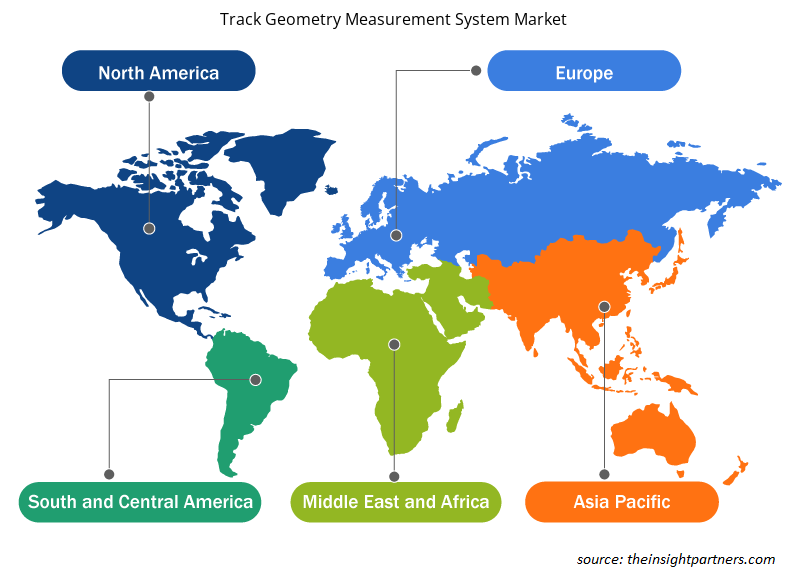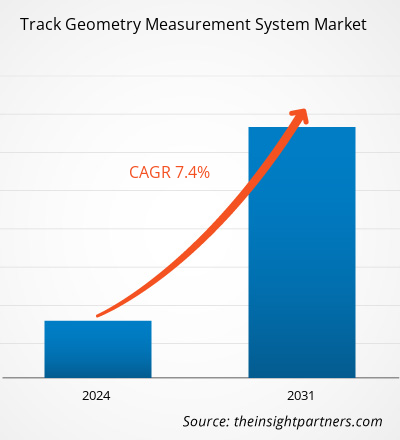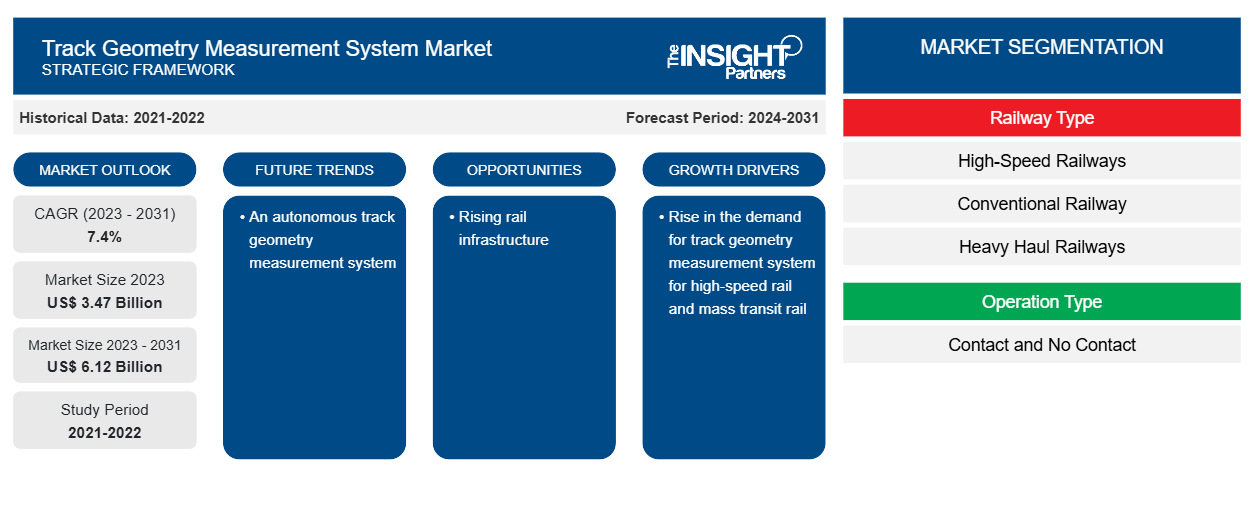Se prevé que el tamaño del mercado de sistemas de medición de geometría de vías alcance los 6.120 millones de dólares en 2031, frente a los 3.470 millones de dólares en 2023. Se espera que el mercado registre una CAGR del 7,4 % entre 2023 y 2031. Es probable que el aumento de la demanda de soluciones para aumentar la seguridad ferroviaria y la expansión de la red ferroviaria sigan siendo claves para las tendencias del mercado de sistemas de medición de geometría de vías.
Análisis del mercado de sistemas de medición de geometría de vías
Existen múltiples normas y reglamentos que rigen la industria ferroviaria y, para cumplirlos, se requiere un sistema de medición de la geometría de las vías. La creciente demanda de seguridad en el transporte ferroviario, así como la expansión de las redes ferroviarias y las líneas de metro, son impulsores clave del crecimiento de la industria. Numerosos accidentes y contratiempos relacionados con los trenes han suscitado inquietudes a nivel mundial, lo que ha animado a los gobiernos a digitalizar el modo de transporte para garantizar un viaje más seguro. Además, la mayor demanda de tecnologías inteligentes para mantener la eficiencia operativa de las vías está impulsando el crecimiento del mercado de sistemas de medición de la geometría de las vías.
Descripción general del mercado de sistemas de medición de geometría de vías
En la industria ferroviaria, el sistema de medición de la geometría de las vías es la técnica más crucial para evaluar la seguridad de las vías y la programación del mantenimiento. Medir y evaluar de forma rutinaria la geometría de las vías ayuda a evitar descarrilamientos relacionados con las vías, que pueden causar daños desastrosos. Las condiciones de la geometría de las vías son una de las principales causas de descarrilamientos relacionados con la interacción entre el vehículo y la vía, como el descarrilamiento por exceso de ancho de vía, el ascenso de las ruedas y el vuelco de los rieles. Las condiciones de la geometría de las vías también pueden provocar roturas de rieles, rotura de sujetadores y descarrilamientos por desalineación térmica. El sistema de medición de la geometría de las vías proporciona la capacidad fundamental de garantizar que la condición de la geometría de las vías se encuentre dentro de los límites aceptables para operaciones seguras.
Personalice este informe según sus necesidades
Obtendrá personalización en cualquier informe, sin cargo, incluidas partes de este informe o análisis a nivel de país, paquete de datos de Excel, así como también grandes ofertas y descuentos para empresas emergentes y universidades.
-
Obtenga las principales tendencias clave del mercado de este informe.Esta muestra GRATUITA incluirá análisis de datos, desde tendencias del mercado hasta estimaciones y pronósticos.
Impulsores y oportunidades del mercado de sistemas de medición de geometría de vías
El aumento de la demanda de sistemas de medición de geometría de vías para ferrocarriles de alta velocidad y transporte masivo favorece el mercado
Se prevé que el mercado mundial de sistemas de medición de la geometría de las vías se expanda rápidamente debido a la mayor demanda de trenes de alta velocidad. Los desarrollos de trenes de alta velocidad han avanzado de manera constante, impulsando el mercado mundial de sistemas de medición de la geometría de las vías. Uno de los principales impulsores del mercado de sistemas de medición de la geometría de las vías es la presencia de una amplia gama de especificaciones y legislación de la industria ferroviaria, así como la necesidad de incorporar soluciones de medición de la geometría de las vías para cumplir con estas normas. Otros factores que impulsan el mercado de sistemas de medición de la geometría de las vías incluyen la introducción de sistemas de geometría de las vías para el mantenimiento de las vías y la expansión de las redes de metro y trenes de alta velocidad.
Infraestructura ferroviaria en auge
La demanda mundial de transporte está aumentando a un ritmo más rápido. Según la Agencia Internacional de Energía (AIE), en 2019 se espera que las actividades de pasajeros y mercancías crezcan el doble para 2050. Según el Grupo del Banco Mundial, los ferrocarriles son una de las formas más eficientes de transportar pasajeros y mercancías. Debido a este aumento de las actividades de transporte, el Grupo del Banco Mundial apoya el desarrollo de la industria ferroviaria para que sea más eficiente. Apoya a los gobiernos de los países en desarrollo en la reforma de la infraestructura ferroviaria y la incorporación de los ferrocarriles a la red de transporte de un país. Además, los gobiernos de los países en desarrollo también están invirtiendo para impulsar su industria ferroviaria. Según la India Brand Equity Foundation, para la infraestructura y el desarrollo ferroviario, el país invertirá alrededor de 715.410 millones de dólares para 2030. Estas inversiones e iniciativas del gobierno y las asociaciones están impulsando el crecimiento de la industria ferroviaria. Por tanto, la creciente infraestructura ferroviaria genera la demanda de soluciones para evaluar con precisión la geometría de las vías del tren en una variedad de condiciones operativas.
Análisis de segmentación del informe de mercado del sistema de medición de geometría de vías
Los segmentos clave que contribuyeron a la derivación del análisis del mercado del sistema de medición de geometría de vías son el tipo de ferrocarril, el tipo de operación y el componente.
- Por tipo de ferrocarril, el mercado se segmenta en ferrocarriles de alta velocidad , ferrocarriles convencionales, ferrocarriles de transporte pesado y ferrocarriles ligeros. El segmento de ferrocarriles convencionales tuvo la mayor participación de mercado en 2023.
- Según el tipo de operación, el mercado se segmenta en con y sin contacto. El segmento con contacto tuvo la mayor participación de mercado en 2023.
- Por componentes, el mercado está segmentado en hardware, software y servicios. El segmento de hardware tuvo la mayor participación de mercado en 2023.
Análisis de la cuota de mercado del sistema de medición de geometría de vías por geografía
El alcance geográfico del informe de mercado del sistema de medición de geometría de vías se divide principalmente en cinco regiones: América del Norte, Asia Pacífico, Europa, Medio Oriente y África, y América del Sur/América del Sur y Central.
Se espera que la región de Asia Pacífico crezca con la CAGR más alta. El rápido desarrollo de los sistemas ferroviarios en la región exige soluciones sólidas para mejorar la seguridad ferroviaria, lo que impulsa el mercado de sistemas de medición de geometría de vías en la región de Asia Pacífico. El aumento de las redes ferroviarias y las líneas de metro en la región impulsa aún más el crecimiento del mercado de sistemas de medición de geometría de vías en la región.
Perspectivas regionales del mercado de sistemas de medición de geometría de vías
Los analistas de Insight Partners explicaron en detalle las tendencias y los factores regionales que influyen en el mercado de sistemas de medición de geometría de vías durante el período de pronóstico. Esta sección también analiza los segmentos y la geografía del mercado de sistemas de medición de geometría de vías en América del Norte, Europa, Asia Pacífico, Oriente Medio y África, y América del Sur y Central.

- Obtenga datos regionales específicos para el mercado de sistemas de medición de geometría de vías
Alcance del informe de mercado del sistema de medición de geometría de vías
| Atributo del informe | Detalles |
|---|---|
| Tamaño del mercado en 2023 | US$ 3,47 mil millones |
| Tamaño del mercado en 2031 | 6.120 millones de dólares estadounidenses |
| CAGR global (2023 - 2031) | 7,4% |
| Datos históricos | 2021-2022 |
| Período de pronóstico | 2024-2031 |
| Segmentos cubiertos |
Por tipo de ferrocarril
|
| Regiones y países cubiertos |
América del norte
|
| Líderes del mercado y perfiles de empresas clave |
|
Densidad de actores del mercado de sistemas de medición de geometría de vías: comprensión de su impacto en la dinámica empresarial
El mercado de sistemas de medición de geometría de vías está creciendo rápidamente, impulsado por la creciente demanda de los usuarios finales debido a factores como la evolución de las preferencias de los consumidores, los avances tecnológicos y una mayor conciencia de los beneficios del producto. A medida que aumenta la demanda, las empresas amplían sus ofertas, innovan para satisfacer las necesidades de los consumidores y aprovechan las tendencias emergentes, lo que impulsa aún más el crecimiento del mercado.
La densidad de actores del mercado se refiere a la distribución de las empresas o firmas que operan dentro de un mercado o industria en particular. Indica cuántos competidores (actores del mercado) están presentes en un espacio de mercado determinado en relación con su tamaño o valor total de mercado.
Las principales empresas que operan en el mercado de sistemas de medición de geometría de vías son:
- Balfour Beatty S.A.
- Sistemas Bentley, Inc.
- ENSCO, Inc.
- ESIM Srl
- Fugro
- Goldschmidt
Descargo de responsabilidad : Las empresas enumeradas anteriormente no están clasificadas en ningún orden particular.

- Obtenga una descripción general de los principales actores clave del mercado de sistemas de medición de geometría de vías
Noticias y desarrollos recientes del mercado de sistemas de medición de geometría de vías
El mercado de sistemas de medición de geometría de vías se evalúa mediante la recopilación de datos cualitativos y cuantitativos posteriores a la investigación primaria y secundaria, que incluye publicaciones corporativas importantes, datos de asociaciones y bases de datos. A continuación, se incluye una lista de los avances del mercado:
- En noviembre de 2023, Brightline adjudicó un contrato a ENSCO Rail para proporcionar tecnología de inspección ferroviaria autónoma para su red ampliada de Florida. La tecnología de medición de la geometría de las vías y el desgaste de los rieles de ENSCO utiliza sensores y algoritmos para medir los parámetros de los rieles en tiempo real y brindar una evaluación integral del estado de las vías de la red. Al monitorear de forma autónoma el estado de la infraestructura de las vías, esta tecnología respalda las decisiones de gestión de activos para mantener en servicio la red ferroviaria de Brightline. (Fuente: Brightline, comunicado de prensa, 2023)
Informe de mercado sobre sistemas de medición de geometría de vías: cobertura y resultados
El informe “Tamaño y pronóstico del mercado del sistema de medición de geometría de vías (2021-2031)” proporciona un análisis detallado del mercado que cubre las siguientes áreas.
- Tamaño del mercado y pronóstico a nivel global, regional y nacional para todos los segmentos clave del mercado cubiertos bajo el alcance
- Dinámica del mercado, como impulsores, restricciones y oportunidades clave
- Principales tendencias futuras
- Análisis detallado de las cinco fuerzas de Porter y PEST y FODA
- Análisis del mercado global y regional que cubre las tendencias clave del mercado, los principales actores, las regulaciones y los desarrollos recientes del mercado.
- Análisis del panorama de la industria y de la competencia que abarca la concentración del mercado, el análisis de mapas de calor, los actores destacados y los desarrollos recientes
- Perfiles detallados de empresas
- Análisis histórico (2 años), año base, pronóstico (7 años) con CAGR
- Análisis PEST y FODA
- Tamaño del mercado, valor/volumen: global, regional y nacional
- Industria y panorama competitivo
- Conjunto de datos de Excel
Informes recientes
Testimonios
Razón para comprar
- Toma de decisiones informada
- Comprensión de la dinámica del mercado
- Análisis competitivo
- Información sobre clientes
- Pronósticos del mercado
- Mitigación de riesgos
- Planificación estratégica
- Justificación de la inversión
- Identificación de mercados emergentes
- Mejora de las estrategias de marketing
- Impulso de la eficiencia operativa
- Alineación con las tendencias regulatorias























 Obtenga una muestra gratuita para - Mercado de sistemas de medición de geometría de vías
Obtenga una muestra gratuita para - Mercado de sistemas de medición de geometría de vías